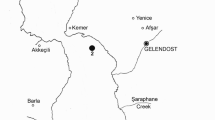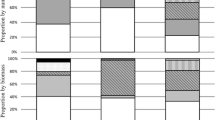Abstract
This study documents predation by the endangered tidewater goby, Eucyclogobius newberryi, upon the invasive New Zealand mudsnail, Potamopyrgus antipodarum, in Big Lagoon, California, USA. To estimate the prevalence of NZ mudsnails in the diet of tidewater goby, the gastric contents of 411 individuals, collected monthly from April 2009 to August 2010, were examined. NZ mudsnails were found in the digestive tract of tidewater goby that ranged in size from 14 to 52 mm total length, corresponding to post-settlement and nearly maximal sizes of this species. Unlike other native species which are unable to extract nutrition from these snails, tidewater goby fully digest this hard-shelled prey, as evidenced by the presence of shell fragments and complete absence of intact shells in the hind gut. The number of ingested NZ mudsnail ranged from 1 to 27 (mean 4.4), and ranged in length from 0.39 to 4.0 mm. The average size of ingested snails increased with fish length (r 2 = 0.42, P < 0.001). NZ mudsnails were found in over 80% of individuals during the summer and fall of 2009, when the estimated population size of tidewater goby in Big Lagoon was greater than three million. This study documents the first instance of a native and endangered species that preys upon and utilizes the NZ mudsnail as a food source, and suggests that tidewater goby can exert substantial predation pressure upon NZ mudsnails and take advantage of these readily available novel prey items.

Similar content being viewed by others
References
Aamio K, Bornsdorff E (1997) Passing the gut of juvenile flounder Platichthys flesus (L.) differential survival of zoobenthic prey species. Mar Biol 129:11–14
Alonso A, Castro-Díez P (2008) What explains the invading success of the aquatic mud snail Potamopyrgus antipodarum (Hydrobiidae, Mollusca)? Hydrobiologia 614:107–116
Bersine K, Brenneis VEF, Draheim RC, Wargo Rub AM, Zamon JE, Litton RK, Hinton SA, Sytsma MD, Cordell JR, Chapman JW (2008) Distribution of the invasive New Zealand mudsnail (Potamopyrgus antipodarum) in the Columbia River Estuary and its first recorded occurrence in the diet of juvenile Chinook salmon (Oncorhynchus tshawytscha). Biol Invasions 10:1381–1388
Bowler P (1991) The rapid spread of the freshwater Hydrobiid snail, Potamopyrgus antipodarum (Gray), in the Middle Snake River, Southern Idaho. Proc Desert Fish Council 21:173–182
Gangloff MM (1998) The New Zealand mudsnail in Western North America. Aquat Nuis Species 2:25–30
Gérard C, Blanc A, Costil K (2003) Potamopyrgus antipodarum (Mollusca: Hydrobiidae) in continental aquatic gastropod communities: impact of salinity and trematode parasitism. Hydrobiologia 493:167–172
Girard C (1857) Contributions to the ichthyology of the western coast of the United States from specimens in the museum of the Smithsonian Institution. In: Proceedings academy of natural sciences of philadelphia, vol VIII. pp 131–137
Hall RO, Tank JL, Dybahl MF (2003) Exotic snails dominate nitrogen and carbon cycling in a highly productive stream. Frontiers Ecol Environ 1:407–411
Hall RO, Dybdahl MF, VanderLoop MC (2006) Extremely high secondary production of introduced snails in rivers. Ecol Appl 16:1121–1131
Jacobsen R, Forbes VE (1997) Clonal variation in life-history traits and feeding rates in the gastropod, Potamopyrgus antipodarum: performance across a salinity gradient. Funct Ecol 11:260–267
Jessen RJ (1978) Statistical survey techniques. John Wiley and Sons, New York
Kearns BL, Dybahl MF, Gangloff MM, Jannot JE (2005) Potamopyrgus antipodarum: distribution, density, and effects on native macroinvertebrate assemblages in the Greater Yellowstone Ecosystem. J North Am Benthol Soc 24:123–138
Levri EP (1998) Perceived predation risk, parasitism, and the foraging behavior of a freshwater snail (Potamopyrgus antipodarum). Can J Zool 76:1878–1884
Levri EP, Kelly AA, Love E (2007) The invasive New Zealand mud snail (Potamopyrgus antipodarum) in Lake Erie. J Great Lakes Res 33:1–6
Richards DC (2002) The New Zealand mudsnail invades the Western United States. Aquat Nuisance Species 4:42–44
Rodriguez LF (2006) Can invasive species facilitate native species? Evidence of how, when and why these impacts occur. Biol Invasions 8:927–939
Scharf FS, Juanes F, Rountree RA (2000) Predator size–prey size relationships of marine fish predators: interspecific variation and effects of ontogeny and body size on trophic-niche breadth. Mar Ecol Prog Ser 208:229–248
Swenson RO (1999) The ecology, behavior, and conservation of the tidewater goby, Eucyclogobius newberryi. Environ Biol Fish 55:99–114
Swenson RO, McCray AT (1996) Feeding ecology of the tidewater goby. Trans Am Fish Soc 125:956–970
Swift CC, Nelson JL, Maslow C, Stein T (1989) Biology and distribution of the tidewater goby, Eucyclogobius newberryi (Pisces: Gobiidae) of California. Contributions in science 404. Natural History Museum of Los Angeles County, Los Angeles
Vinson MR, Baker MA (2008) Poor growth of rainbow trout fed New Zealand mud snails, Potamopyrgus antipodarum. North Am J Fish Manag 28:701–709
Zaranko DT, Farara DG, Thompson FG (1997) Another exotic mollusk in the Laurentian Great Lakes: the New Zealand native Potamopyrgus antipodarum (Gray 1843) (Gastropoda, Hydrobiidae). Can J Fish Aquat Sci 54:809–814
Acknowledgments
Funding for this study was provided by the United States Fish and Wildlife Service (USFWS). We would like to thank E. Tonning for laboratory assistance with diet analysis. Our gratitude to D. Ward, D. Hankin, T. Mulligan and two anonymous reviewers for providing useful comments that helped to improve this manuscript. Samples were collected either by the USFWS or under California Scientific Collecting Permit SC-10527 following IACUC protocol (08/09.F.44.A).
Author information
Authors and Affiliations
Corresponding author
Rights and permissions
About this article
Cite this article
Hellmair, M., Goldsmith, G. & Kinziger, A.P. Preying on invasives: the exotic New Zealand mudsnail in the diet of the endangered tidewater goby. Biol Invasions 13, 2197–2201 (2011). https://doi.org/10.1007/s10530-011-0054-3
Received:
Accepted:
Published:
Issue Date:
DOI: https://doi.org/10.1007/s10530-011-0054-3




